
ABOVE: From Maggie’s second-floor studio the view into her back garden is framed by the dense greenery of Weeping Elm, rhododendron, euonymus, and a single Japanese white pine.

ABOVE: From Maggie’s second-floor studio the view into her back garden is framed by the dense greenery of Weeping Elm, rhododendron, euonymus, and a single Japanese white pine.
With steady hands, Maggie Foskett carefully arranges a small piece of red leaf lettuce and a lacy maple seed between two thin squares of glass and holds them up to the light. “I’m nearsighted, so I always need to look closely at things. If something has a vibrant color or unusual shape, I want to pick it up and touch it. They’re really small marvels—when I find them I like to record them.”
In her darkroom on Florida’s Sanibel Island, Maggie spends the winter creating images with a cameraless photographic technique called cliché-verre. In a tiny rectangle of glass the size of a 35mm slide, she layers found bits of nature and begins the arduous process of transforming them into large, brilliant Cibachrome prints.
“With photography, I think you’re missing something if you don’t fool around in the darkroom,” Maggie says. She took up photography at the age of fifty-seven and became interested in cliché-verre almost immediately. Developed by William Fox Talbot in the early 1800s, the technique originally involved drawing on glass and using sunlight to make a direct print onto light-sensitive paper. Maggie has adapted the technique using an enlarger to capture the colors and details of translucent organisms in compositions that magnify their unexpected patterns and surprising beauty. Over the years she has varied the process to include the use of contact-printed X-rays. When utilizing organic material such as a luna moth, she must work quickly and precisely because her chosen material will soon deteriorate, resulting in only one or just a few final prints.
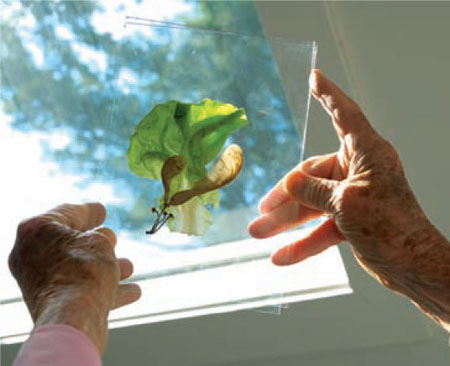
ABOVE: Choosing objects with translucent properties, Maggie enlarges them in her prints to reveal the intricate patterns within their structure.
With the same exacting eye and sensitivity to nature’s form and detail, Maggie has composed a small marvel of a garden within the rectangular boundaries of her summer residence in Camden, Maine. When Maggie and her husband, John, moved here in 1983, the backyard was a patch of grass. Maggie laid out the plan for her Japanese-inspired garden with string, then hired a down east carpenter to construct the deck, which is the centerpiece of the design. Inspired by the bow of a beloved boat they have since donated to a nonprofit institute, the deck is an intersecting series of triangles at varying levels surrounded by and interplanted with a range of hardy, low-maintenance shrubs, specimen trees, and perennials.

ABOVE: The geometry of the cedar decking makes a striking visual statement. Blue Rug juniper is allowed to creep over the edges of the weathered wood and soften its strong lines.
The grayed cedar deck creates the framework within which Maggie has constructed her garden of contrast and pattern. In much the same way as she makes her cliché-verre compositions, she has chosen and arranged the garden elements carefully. But as she has discovered in making her prints, nature is ever-changing, so the results are often unpredictable. That delights her.
Over the years, the surrounding trees have grown and shaded the yard, helping to define its structure through shape and scale. “My small garden, submerged in shade, is dependent upon shape and contrast—the shape of lichen-covered rocks, the contrast between the texture of foliage and the deck’s weathered wood.” Maggie loves how the ragged edges of low-growing foliage contrast with the geometric lines of the decking. “A natural flow of line” is also crucial, she emphasizes. “Nothing is pruned to the precision of a shaving brush.”
“My small garden, submerged in shade, is dependent upon shape and contrast.”

ABOVE: In a deeply shaded rock garden in front of the house, pachysandra, hostas, and low-growing azaleas thrive in the cool, moist soil.
“They’re really small marvels—when I find them I like to record them.”

ABOVE: Maggie in her Maine studio.
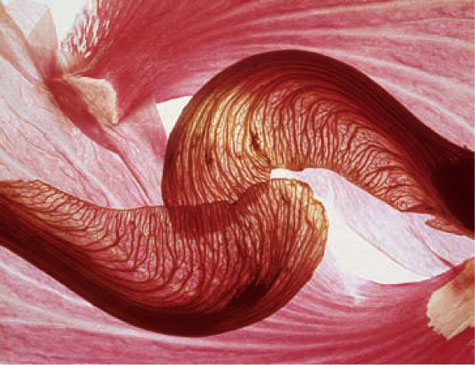
ABOVE: Whirlybird derives its composition and color from radicchio leaves and the winged seeds of a silver maple tree.
If a plant survives in the harsh northern climate, it stays. If it fails, Maggie does not attempt to replant. What does survive flourishes. At one edge of the deck, volunteer ferns sprouted and spread, obstructing a large stone. So Maggie moved the stone to another location. “These plants are like characters in a book who tell the author what they want to be. I’m not the boss here.”
Maggie may not have ultimate control over the plant life in her garden, but much of the hardscape is a product of her passion for stones. She hauls them from local beaches and arranges them in groups that create visual anchors for the plant material. Sometimes, following the advice of a seasoned local, Maggie pours buttermilk over lichens to encourage their spread. Because they can tolerate environmental extremes, lichens are almost eternal. “If there’s any vegetation on Mars, it’s likely to be lichen,” she says.
Scrambling around the rock yard in nearby Rockland looking for just the right stone, Maggie is attracted by shapes and patterns. When an overgrown cypress began to dominate the center of her garden, she ripped it out and went rock hunting. The focal point of Maggie’s collection of stones is a group of three hand-cut well covers. She speculates that the huge granite slabs were hauled by dray horses from hills scarred by retreating glaciers. Farmers placed the slabs over newly dug wells, their circular holes having been chiseled out by skilled stonecutters. Tilted upright now, these natural sculptures throw patterns of light over hostas and a pair of long-legged cast-metal wading birds.
Perhaps because Maggie was born and raised in Brazil, her choices in flowering plants tend toward exotic colors. Throughout the garden, gray stone and green foliage are punctuated season to season by bursts of intensely rich hues. In spring, the curved wooden walkway to the front door of the house is canopied by the vivacious, frilly blossoms of chrome yellow and deep peach azaleas. The two-story rhododendron that creates a green wall along one edge of the backyard is dotted with bright magenta flower heads until early summer.
Each year, on a raised triangular platform in the middle of the deck, Maggie arranges a display of annuals in large simple pots. Some years the pots hold long-blooming Mandevilla senderi ‘Rosea’, also known as dipladenia or Brazilian jasmine or simply Mandevilla ‘Rosea’. Its thick, glossy leaves and deep pink blossoms are still lush when the plants are brought indoors in late fall. Other years, petunias and annual Argyranthemum (marguerites) in shades of pink and deep magenta burst from cylindrical white planters. By the back entrance to the house, another mandevilla vine, “Red Velvet” blooms from the Fourth of July until Thanksgiving. It’s no surprise that one of Maggie’s favorite potted plants is Passiflora incarnata, a native form of passionflower whose blooms are smaller and less showy than those of the cultivated species but no less intriguing.

ABOVE: Picking up on the hues of the neighboring rhododendron, pots of annual petunias and Argyranthemum create a strong color focus.
Maggie’s summer garden is a constant source of wonder and reflection, yet she produces no artwork while she’s in Maine. From June until November, when she’s not gardening, she spends her time visiting galleries, keeping in contact with other artists, and absorbing creative stimulation from her surroundings on the midcoast. She spends the winter months in the self-imposed isolation of her Florida studio. “I think many artists are naturally people of solitude. I never go out, never go to lunch. I need to save any time I have to work.”
Into that isolation Maggie brings the raw material of constant observation and study. “There is an infinite variety of patterns in the way plants behave. There is always something else to see.” The roots of a hydroponic lettuce that remind her of a rain forest, a slice of grapefruit from her tree in Sanibel—all are transformed in her darkroom into the tonal poetry of color and light.
Maggie’s work can be seen as a form of poetry—the unexpected transfiguration of something ordinary, such as an onion, into something quite different. “To me, a slice of onion suggests the constant changes in a human cell. Writers transform the commonplace with words. I try to do the same through cliché-verre in my darkroom.”
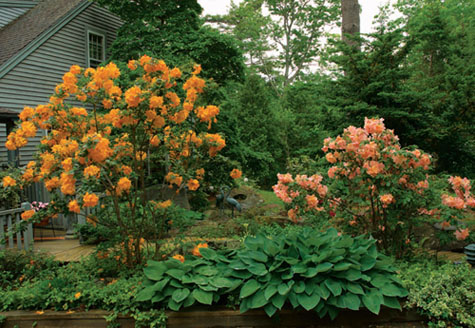
Along the front walkway to the house, surrounded by foliage, structures, and sculpture in shades of greens and grays, these orange and peach azalea blossoms are rendered even more brilliant than they would be in a garden that included other colors.
One of Maggie’s favorite poets is a fellow Bryn Mawr alumna Marianne Moore. The last lines of Moore’s poem When I Buy Pictures, could easily be referring to Maggie’s work:
It comes to this: of whatever sort it is
it must be “Lit with piercing glances into the life of things,”
it must acknowledge the spiritual forces which have made it.
Maggie refers to herself as a “rag picker of small finds,” a collector of the fragments of nature that cross her path. What emerges from her vision is a glimpse of what others often overlook. She believes that all nature is connected: “Thousands of years ago the glaciers of the last ice age melted and left striking patterns that exist around us today. We collect the rocks, and we carry within us the bones and cells of our ancestors. Whether to keep a garden alive or not is to experience the delicate balance of our mortality. As the Greek philosopher Xenophanes said, ‘We are all sprung from earth and water.’”
Discovering Form and Pattern
| The structure of even the smallest elements in the garden often reveal intricate patterns. Both the early new growth (left) and the blue-green cones (middle) of Japanese white pine (Pinus parviflora) are worthy of close examination. Japanese andromeda (right) are best known for their pendulous clusters of white spring flowers, but their equally intriguing seed pods will last until winter. | 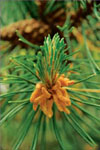 |
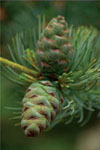 |
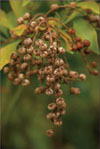 |